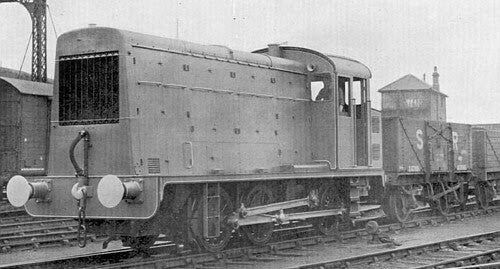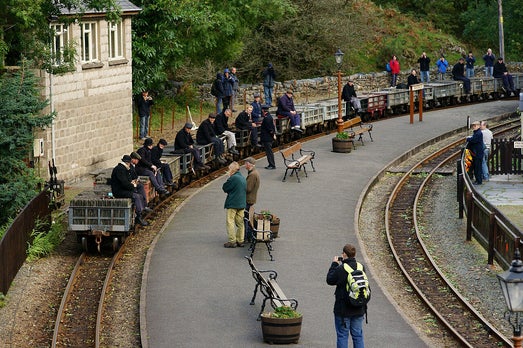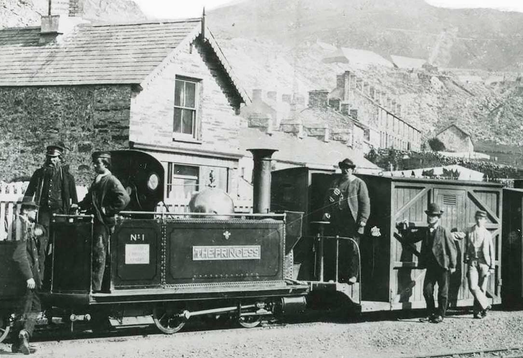Information
Welcome to Rail Ride in Time's exploration of industrial railways! Discover the often-overlooked yet vital role these railways played in the industrial development of the United Kingdom.
This page will delve into the history of industrial railways, those often ignored but a major part of the industrial development of the United Kingdom. These include lines built and maintained by industries to connect mines or smaller industrial sites to main lines or ports.

An industrial roller coaster.
The gravity train on the Ffestiniog Railway
Using gravity to move goods on early railways in Britain is certainly nothing too unusual. There have been examples across the country. Although these have usually been short distances and the full waggons going down bring used to pull the empties back up. The Ffestiniog Railway, a narrow gauge line, opened in 1832, and used this principle very differently. The owners decided to use this method along the entire line, making use of the seven hundred foot drop from the Slate quarries at Blaenau Ffestiniog, down to the wharfs of Porthmadog. The empty waggons were then hauled up in smaller groups by horses[1]. This method proved highly effective as a train of about one hundred waggons could be sent down the hill in one go, the dock workers would then unload them while the horses took the empties back up ready for filling and adding to the new train. Given that locomotives at the time needed the route to be as flat as possible. When Isambard Kingdom Brunel designed the Great Western Railway, he changed it from the originally proposed route to another and then still wound round hills as best he could. Giving the railway its nickname the ‘Great Way Round’[2]. When running downhill, unlike a roller coaster it would have been dangerous to allow it to head pell mell down the hill, the speeds it would hit would lead to a lot of derailment. Stopping a train more than a hundred tonnes in weight would have also been a challenge. The train would need to be slowed down to allow upcoming horses and empties to pass at certain points along the line. To allow this to happen, the Ffestiniog Railway, would put braked waggons at various points along the train, these would be operated by two or three men, and in a way that would make a modern Health and Safety inspector cringe, they would run up and down the train applying or realising the brakes as needed[3]. Despite how this sounds there were only a few injuries and no deaths from this method of controlling the train. Technology does get better over time and after the possible incursion into their area from the Aberystwyth and Welch Coast Railway in the 1860’s[4], the Ffestiniog Railway needed to speed up the travel time of their trains to stave off the interloper. So, they looked at getting steam locomotives onto the line, the first one to be used was not a wise investment. ‘Little princess’ did not have sufficient power. The Ffestiniog turned to an innovative designer Robert Fairlie, who came up with a contraption that looked like two locomotives put back to back and fixed together. This did the trick, and they were brought in to service. at first, they would run behind the trains to give them a shove if need, then connect to the empty train at the bottom and take it back up to the quarry. When passenger travel was commenced in 1864[5], this was the same method used for all trains, until the Board of Trade put a stop to using this method with any train carrying passengers in 1871[6]. As was stated at the beginning this was not a method that was unknown in the railway world. What make them unusual though was the fact the Ffestiniog continued to use this method right up until the start of the Second World War. This method did allow the Ffestiniog to save a lot of money on upgrades needed to rolling stock at the end of the nineteenth century. The release of the Regulation of Railways act 1889, after the Armah Train disaster of the same year forced all rail companies to used continuous brakes to ensure that trains could not roll down a hill if disconnected to a locomotive[7]. In his day log dated21 December 1889,John Hughes the general manager stated that the method currently used, having multiple braked goods waggons in a train would mean that the effect would be the same as having continuous braking fitted. Negating the need for the expense[8]. Now run as a heritage line, the Ffestiniog Railway still runs gravity trains to this day, see their website Home Page - Ffestiniog & Welsh Highland Railways .
[1] Peter Johnson, Festiniog Railway: A view from the past, (Runnymede, 1997) p 14
[2] Andrew Roden, Great Western Railway: A history (London, 2012) p 5
[3] Stewart D McFarlane, Gravity Trains, 2007 available at: Gravity slate trains - Festipedia accessed 07 June 2025.
[4] Alun John Richards, The Slate Railways of Wales (Llanrwst, 2001) pp 13-16
[5] John Winton The Little Wonder:150 years of the Ffestiniog Railway, (London, 1986) p 53.
[6] Stewart D McFarlane, Gravity Trains, 2007 available at: Gravity slate trains - Festipedia accessed 07 June 2025.
[7] Christian Wolmar, Fire and Steam: How the railways transformed Britain, (London, 2007) pp166 -167
[8] Unknown, Day log/ 1889-12-21, 2019 available at: https://www.festipedia.org.uk/w/index.php?title=Day_Log/1889-12-21&oldid=71237, accessed on 07 June 2025.



Wootton Bassett Dairy.
1908 saw the introduction to Wootton Bassett of the Dairy Supply Company. Being in the heart of dairy country, and with milk being transported regularly in the area, it was inevitable that such a company would setup in the area somewhere. Wootton Basset was the perfect place. Being a main junction itself with lines running east and west towards major destinations such as London, Bristol and the heart of Wales along the Great Western Railway and beyond. The business grew quickly that the company had to look to use and alternative to the milk churns of the time. By this time tank wagon had been designed that could carry the milk in bulk and were able to be loaded and unloaded rapidly at processing and distribution plants. By 1927, now being part of United Dairies, the distribution plant on Station Road was using these vehicles to move more milk around more efficiently. Despite general traffic to Wootton Bassett Junction on 19 May 1962, St Ivel as it was now called was still running milk traffic by rail from there until around 1970. When rail traffic was replaced completely by road transport. The area has now been re developed into a housing and industrial area, and the only reminders visible on a map are the names of some of the roads, Butter Milk Crescent, Churn Way and Dairy View. However, in the Royal Wootton Bassett museum there is a recreation of the area in OO gauge.


Create Your Own Website With Webador